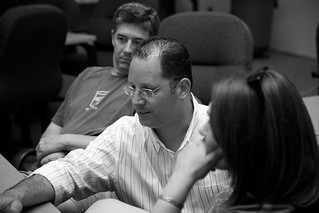Community First
| Michael Wesch by flickr user poptech |
Mike sighed, put both hands on the podium and said: "That's really hard work."
He went on to explain "community first." He uses the first two weeks of class to build a sense of community and togetherness in a shared quest to solve a real world problem. A problem he himself doesn't know the answer to.
"Doing crazy things together creates community."
Micheal plans his most passionate and enthusiastic lectures for those first two weeks. And he has his students do zany ice-breaking activities to help them get to know each other and break through the veneer of passivity they arrive in his class with. But it's not just about having fun; these activities (like human scavenger hunts) all have a serious edge to them. They have to see that they'll have fun learning here, but we are working hard at learning.
The Lesson Design Arc: schedule-research-paper-video
The kids begin by co-creating a schedule on a wiki for the research they'll do to solve the problem they've decided to work on. They begin by digging into the problem and reading everything they can on it. Summaries of all their reading are compiled on the wiki. Typically they'll read over 90 articles, papers, or books in the first week of class as they do this. (In more typical University classes they read about three articles in the first week.) Mike guides them, having a little deeper experience in the field then they do, by suggesting other sources they might wish to explore. They continue this research and co-create a research paper for publication. When that's all done, they create very brief condensed video summaries of their research, submit them to Mike who then weaves them together into a brief (5 min?) video. All this is only possible because of the community building work they do together in the first few weeks of the course.
There's a lot more to all this, I'm just summarizing (his integrated, collaborative, calibrated peer review assessment scheme – which goes well beyond <-- that link back there – is brilliant), but that's the broad strokes takeaway I got.
When Things Go Wrong
| My Pencil by flickr user jbelluch |
When that happens Mike intervenes using a ritual he learned from an African(?) tribe. It's very similar to the Talking Stick ritual used by many First Nations people of Canada. They use pencils instead. Anyone who is holding the pencil lets go of the little voice in their head that says "You can't say that." and speaks from the heart about what's upset them. The rest of the group talks with them about it. They don't put the stick down until they've resolved whatever the problem is. Mike usually goes first. Sometimes he cries while he's talking to his 400+ students. Then the next person in the group takes their turn.
A Pedagogy to Aspire To
Isn't that an amazing example of "intense imagination, motivation, emotion, and thought?" I had wanted to write about the amazing conversations going here: in the halls, in sessions, over lunch, every time someone stops me to talk really. But this morning's keynote. Just breathtaking. Good teaching is what comes from building strong relationships between teachers and students; relationships with a serious educational edge. (I hear echoes of John Seely Brown in this.)
I've got to think more about how to weave together such a set of diverse sensitivities into my teaching. How do you build a culture of caring in your class?
- 7/15/2010 11:58:00 pm
- 9 Comments

